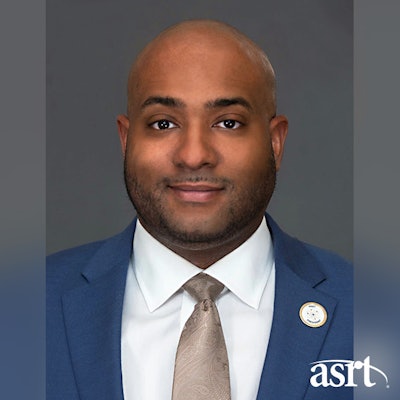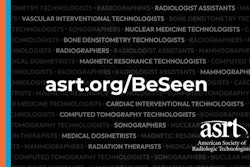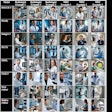A range of federal and state legislation and other developments in the works could have a significant impact on radiologic technologists (RTs) and registered radiologist assistants (RRAs), either supporting and strengthening these professions or weakening them.
For example, the American Society of Radiologic Technologists (ASRT) is working with lawmakers to reintroduce the federal Medicare Access to Radiology Care Act (MARCA) in the current legislative session. Last introduced in June 2021 as HR-3657 and companion SB-2641, MARCA would amend Medicare reimbursement policy for radiologist assistants (RAs) to align reimbursement with state radiologist assistant licensure laws.
 ASRT President Brandon Smith, MBA
ASRT President Brandon Smith, MBA
If passed, MARCA would ensure complete Medicare reimbursement for services provided by a radiologist assistant, when supervised by a radiologist as part of a radiologist-led patient care team, regardless of the setting in which the service is performed, according to the ASRT. Written into earlier versions of the act, payments would be made to the supervising radiologist at 85% of the amount paid when the services are furnished by the radiologist.
"By not separating radiologist assistant reimbursement policies into different payment categories by service location, the adoption of MARCA would enable radiologists to devote more focused time to reviewing and interpreting complex medical images or urgent cases," the ASRT has said.
The language of MARCA has defined an RRA as a radiographer who is certified by the American Registry of Radiologic Technologists (ARRT) as a registered radiologist assistant or by the Certification Board for Radiology Practitioner Assistants (CBRPA) as a radiology practitioner assistant to perform radiologic procedures under the supervision of a radiologist.
In the past, MARCA has been a joint legislative project of the American Registry of Radiologic Technologists (ARRT), ASRT, and the Society for Radiology Physician Extenders (SRPE). The American College of Radiology (ACR), which collaborated with RT societies to create the RRA position in 2002, has remained neutral on the bill and noted that it continues to be opposed to nonphysician providers (NPPs) performing imaging supervision or interpretation.
"The ACR continues to work with these societies to ensure that RRAs work as part of a radiologist-led team," the ACR said.
Unsuccessful attempts to get MARCA enacted have produced debate and points of contention, such as if MARCA is adopted, RAs will take jobs from radiologists, as some say advanced-practice radiologic technologists have done in Europe, according to the ASRT.
RA training goes beyond what is required for RTs, preparing RAs to become advanced practice RTs or radiologist extenders, credentialing authority ARRT has said in support of related legislation that's been proposed. However, the ASRT, like others, has emphasized that RAs (unlike nurse practitioners or physician assistants) are restricted from making diagnoses and must work under the direct supervision of a radiologist.
Scope creep and state laws
Scope of practice, supervision rules, and state laws are typically discussed when it comes to the work of registered RAs, RTs, and other nonphysician providers. For some, relaxing the rules has caused consternation in the medical field so much so that the American Medical Association (AMA) in late February warned of "scope creep," or expanding the scope of practice for NPPs.
Creating pressure, the U.S. Centers for Medicare and Medicaid Services (CMS) recognized registered RAs (and radiology practitioner assistants) differently in 2019 with changes to supervision requirements under the Medicare Physician Fee Schedule (MPFS). Then the pandemic and public health emergency perpetuated those relaxed requirements, and they remain intact today, raising questions from providers.
"CMS has left language in place in the rules that physicians may provide direct rather than personal supervision when Level 3 tests are performed by RAs and RPAs acting within their scope of practice under state licensing laws," wrote Tom Greeson, partner in the Life Sciences Health Industry Group at Reed Smith in 2021, with colleague Paul Pitts.
Further, CMS allowed physicians and NPPs to provide direct supervision for Level 2 tests that require either the proximity of being present physically or virtually via audio and video (A/V) communications technology in the office suite and immediately available, but not in the room where the test is administered, Greeson further explained for AuntMinnie.com.
Not all states (but a majority) have defined such licensure for these practitioners. Today, states that don't may soon get on board, and states that do may be examining their existing rules for flexibility for those performing certain image-guided tests. Or, they may be changing oversight for NPPs such as radiologist assistants.
The ASRT weighed in, telling AuntMinnie.com, "A key issue we continue to face is state legislation designed to weaken or remove licensure for medical imaging and radiation therapy professionals. ASRT's position, according to ASRT Vice President of Governance and Public Policy Jason Bradley, is that "states should have strong licensure laws to ensure highly qualified and educated professionals are performing medical imaging and radiation therapy procedures. In addition, ASRT continues to work with its affiliates to establish licensure in states with no requirements and states with limited laws on the books."
California is one state that may be changing its terms covering RAs.
California legislation
Recent proposed legislation is alive in California; CA AB-3097 was introduced February 16. Existing law, the Radiologic Technology Act, prohibits certain activities. However, the bill if successful would establish the Radiologist Assistant Practice Act, as well as the Radiologist Assistant Committee within the Medical Board of California.
CA AB-3097 of 2024, which is sponsored by ARRT, prohibits a person from holding themselves out as a radiologist assistant (RA) or using the RA title or any other term to imply or to suggest that the person is an RA unless the person meets specified requirements. The bill was in committee as of April 10.
If passed, CA AB-3097 would establish requirements for registration as an RA. The bill would also prescribe requirements for supervision of a radiologist assistant by a radiologist, prohibit a radiologist assistant from performing specified acts, and make a violation of the act’s provisions a misdemeanor, and, under specified circumstances, subject to a specified civil penalty. By creating a new crime, the bill would impose a state-mandated local program.
An analysis of CA AB-3097 by Vincent Chee, deputy chief consultant for the California State Assembly Committee on Business and Professions, showed that the measure is "not intended to impact existing RT practice, but the current language could be misconstrued to subsequently require the supervision of a radiologist in cases where currently, an RT is being supervised by a nonphysician and after the bill passes, the RT qualifies as an RA."
Virtual supervision of RTs
In Alabama, providers have had questions about RT supervision, leading the Alabama State Board of Medical Examiners to consider declaring a position on what constitutes direct supervision by a board-certified radiologist. An August 2023 statement addressed remote supervision of RTs, specific to their administration of intravenous contrast media.
For CT and MRI procedures where injected contrast media is ordered, "... radiologists have or are in the process of implementing clinical policies and procedures pursuant to which radiologists conduct remote supervision of diagnostic imaging tests involving contrast media administration by radiologic technologists while a nonradiologist healthcare professional, such as a RN, who is licensed and authorized to administer pharmaceuticals, clinical care, and if needed, basic life support is physically present at the facility," stated the ASBME.
"These examples represent a growing acceptance across the country of radiologists conducting direct supervision of radiologic technologists performing intravenous contrast media administration via A/V real-time communications technology," ASBME said.




















